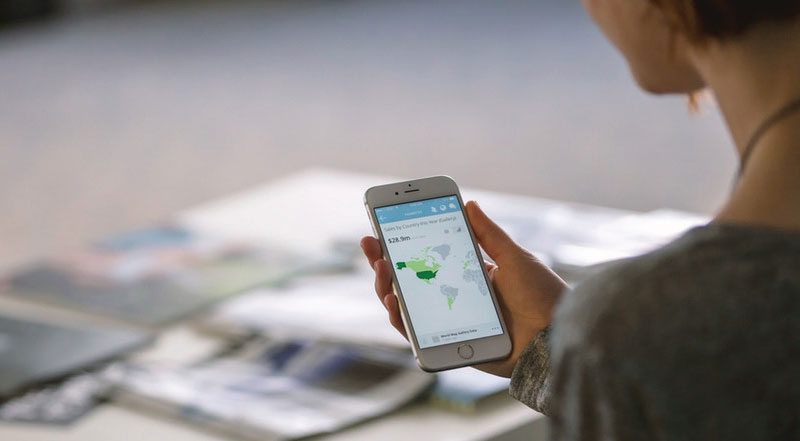It’s hard to believe that it’s been less than a decade since the introduction of the iPhone in 2007 and the launch of what we today think of as mobile apps – those that run on smart phones. It didn’t take long after that launch, however, for businesses and consumers to recognize their benefit – and want more. In fact, it was only four years later, in December 2011, that The New York Times celebrated an extraordinary milestone with an article in its technology section headlined “One Million Mobile Apps, and Counting at a Fast Pace.” Today the Apple store alone grows by around 1,000 apps a day, or 30,000 a month. Apps for Android phones grow at a rate of 15,000 a month.
Businesses deciding whether an app will be a competitive advantage need look no further than data showing just how extraordinary the spread and use of mobile apps are – not to mention how much commerce is being conducted digitally. Today, in fact, not being a part of this explosive growth is a competitive disadvantage.
After all, in the U.S. alone there are 224 million people who use apps (think about that for a minute; there are only 319 million people in the country in the first place and around four million of those are infants). And, among them, the average time people spent on mobile apps increased more than 20 percent in 2014 alone. On average, app users visit 25 different apps a month on their phones.
It’s not all fun and games, though. Commerce conducted over mobile apps has exploded, with research showing that this year alone, ecommerce sales are expected to reach over $2 trillion (yes, trillion), with one-quarter of that coming from mobile by the end of 2017. In other words, if your business doesn’t have a mobile app supporting it, the time is now to reconsider your app-less strategy.
Businesses deciding whether an app will be a competitive advantage need look no further than data showing just how extraordinary the spread and use of mobile apps are, and how not being a part of this explosive growth can be a competitive disadvantage.
People Prefer Apps Over Mobile Websites.
The truth is, movement away from desktop computers and laptops to mobile means that a website, those browser-based HTML pages linked together and accessed over the Internet, is no longer enough to keep businesses relevant. Even websites optimized for mobile use are typically just streamlined copycats of an enterprise’s main website. Today, people want and expect more from their mobile experience, with 85 percent saying they prefer native mobile apps to mobile websites. Mobile app users are more loyal than mobile web users, too, spending 18 times more time a month on the top 1,000 apps than mobile web users spend on the top 1,000 on that platform.
Apps’ Competitive Advantage Is Clear.
If you have a mobile app and your competitors do not, data like this show that you are where your customers are – and they are not. Your customers don’t have to go to you, you’re always there with them. (According to Fast Company , 25 percent of smart phone users ages 18 to 44 can’t even remember the last time their smart phones weren’t next to them.) As a writer for Forbes magazine put it, even when your customers are looking at their phones for other reasons, your icon on their screen registers as they scroll through, making an impression and adding to their relationship with you.

Competitive Advantage Upon Competitive Advantage
Always being with your customers or audiences is a significant advantage. But there are many additional benefits that flow from that mobile presence and visibility, all of which can build on one another and deepen their impact to create a powerful competitive advantage for your business.
Sell more products and services.
If you’re in the business of selling something, no goal is more important than driving revenue by selling more of it. Apps help you do that. In fact, a study published in September 2015 in the Journal of Interactive Marketing showed that over the course of three months, customers who downloaded a branded app increased spending by 19 percent to 48 percent. “It could be a total game changer if a company provides an app that’s well functioning and offers some consumers benefit,” noted the study’s lead author, Su Jung Kim of Iowa State University.
Apps are an anywhere-anytime environment, after all, always open for business, whether a user is intentionally shopping, walking the dog or killing time in line at the airport. With an app, your customers can easily compare prices with what they see in store and what they see on your app, and make the best choice based on that information. If an enterprise offers a brick-and-mortar experience, as well, a branded app can complement the brand’s off-line experience to encourage increased sales online and off.
According to Fast Company, 25 percent of smartphone users ages 18 to 44 can’t even remember the last time their smartphones weren’t next to them.
Build brand loyalty.
People who have gone through the trouble of downloading your app want to be loyal to you, and research backs that up. A report from Adobe Digital Marketing noted that “users of mobile apps are more loyal to the brand versus those who just visit the website from their mobile device.” So an app has to be about more than sales, more than a cold, purely transactional experience. It has to be a place people want to go, a place where they want to spend time, a place they want to return to over and over again. That’s called brand loyalty (as well as customer retention), and your enterprise’s unique personality, together with your app’s features, can combine to create a powerful pull with which none of your competitors can compete.
Your enterprise’s unique personality, together with your app’s features, can combine to create a powerful pull with which none of your competitors can compete.
So if customers download your app, they’ve already shown they care about your brand. They’ve made the effort. Now it’s your turn: loyalty is a two-way street, and brands can’t expect customer loyalty without showing it in return. And that means providing users thoughtful, intuitive design and function, easy-to-navigate features and one-of-a-kind experiences (ranging from entertainment and curated content to just incredibly fast price and product comparison to seamless scheduling of services to coupons and other incentives they can’t find anywhere else). Loyalty via apps can also be built by creating loyalty programs that your users really feel benefit them, whether by saving them money or upgrading their experience.

Target users and provide unique benefits in return.
A mobile app can allow geo-targeting and geo-fencing. You’ll know where your customers are and can use that to offer them information they otherwise wouldn’t have, including time-sensitive special prices, coupons and promotions; real-time updates, and more that’s relevant to their location and interests.
We already know push notifications, which can be sent to users anytime, are effective. In fact, 52 percent of mobile app users enable push messaging on their mobile devices, while according to Forrester Research, marketers saw 50 percent higher open rates on push notifications versus email and click through rates as much as twice as high. “Push notifications are the ideal tool to combine mobile marketing’s unique benefits: intimacy, immediacy, and context” the report notes. Push-notifications’ effectiveness may be amplified significantly when used in combination with geo-targeting and geo-fencing, since those messages will resonate because they’ll be even more relevant to the moment. Again, users have already gone to the trouble of downloading your app; they’re open to hearing from you.
Nothing increases and extends a competitive advantage like making your customers’ lives easier.
Share and share alike.
Apps allow for social interaction between enterprises and their customers and audiences, as well as between customers and audiences themselves. Such integration allows them to share their opinions, rate your offerings, send recommendations and connect to Facebook, Twitter, Instagram and other universal apps where they have followings, followers and friends. Enterprises that integrate their apps with social media can also promote the app on their own social networking pages, inviting commentary by current users as well as adoption by new users.
Finally, make customers’ lives easier.
Even if some of your competitors have enterprise apps, as well, the enterprises that offer the best functionality, the most seamless social integration, the smoothest commercial transactions, the fastest customer service, the cleverest design, and more will enhance their brand value, create an emotional connection with users, improve sales, build trust, trigger excitement and attract new users – business advantages that will leave competitors in the dust.

Building Sustainable Competitive Advantages
Given the time and resources it takes to build a mobile app (see above), ensuring that the competitive advantages it provides remain both relevant and sustainable takes dedication and, yes, additional time and resources.
Listen to your users.
What’s getting traffic, what’s not? Amplify the former; address the latter. What are they asking for more of? What are they challenging you on?
Improve and fix.
Continually look for ways to improve what you already do well and fix quickly what you don’t (it’s easy to lose users, hard to get them back).
Be unique.
If you’re merely playing catch up – a me-too app full of features that your competitors already offer – rethink your strategy. And assuming you are unique, pay attention to the me-too apps that inevitably will follow. In other words, continually think about what’s next.
Build in measurement.
If you can’t measure increased sales, new members, improved customer service or whatever your goals, you won’t know if your app is working. And if you don’t know if it’s working, you won’t know why it’s working or why it’s failing. You can’t fix what you don’t know.
Think content over device.
In other words, create content that makes sense for your brand and your customers first; don’t limit yourself to creating content for only one channel.




